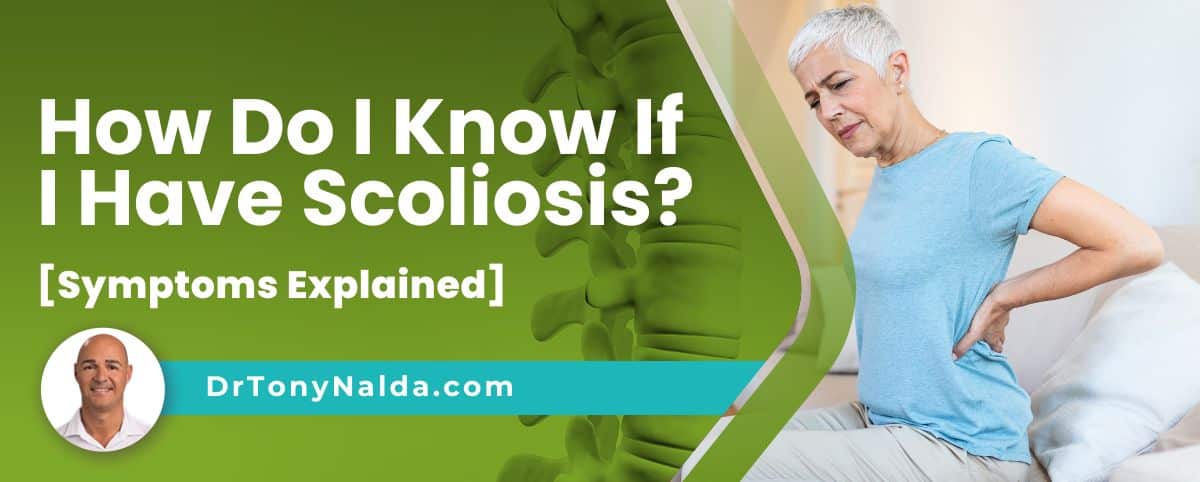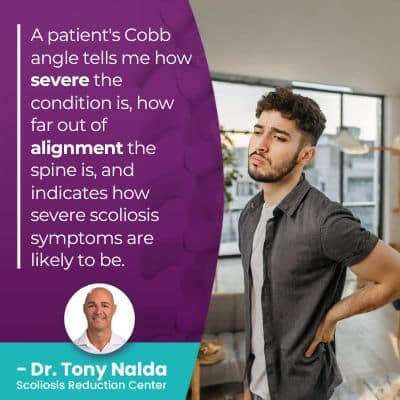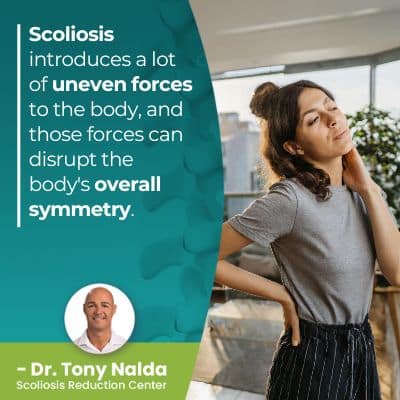How Do I Know If I Have Scoliosis? [Symptoms Explained]

It can be difficult to know when it's time to seek medical help when a change is detected. When it comes to scoliosis, there are different severity levels. Mild scoliosis can have subtle effects, whereas severe scoliosis can cause overt symptoms that tend to become more noticeable over time.
As a progressive condition, scoliosis gets worse over time, and in many cases, when scoliosis is first diagnosed isn't indicative of when the condition developed. Many patients live with scoliosis unaware until symptoms become more severe. A medical examination and X-ray results confirm a diagnosis.
Before exploring the condition's effects to watch out for, let's discuss the diagnostic process.
Table of Contents
Diagnosing Scoliosis
Scoliosis is a highly-prevalent spinal condition that involves the development of an unnatural sideways curvature of the spine that also rotates (twists), making it a complex 3-dimensional condition.
Current estimates have close to seven million people living with scoliosis in the United States alone, and as the leading spinal condition among school-aged children, awareness is needed.
There are a number of different spinal conditions that involve a loss of its healthy curves, but scoliosis has some unique characteristics that set it apart from the rest; not only does the spine have to bend and twist, the size of the unnatural spinal curve has to be specific.
To truly see what's happening in and around the spine, to confirm there is rotation present, and to determine a patient's Cobb angle measurement, a scoliosis X-ray is needed.
Cobb Angle
A patient's Cobb angle measurement is one of the most important pieces of information that treatment plans are shaped around.
 A patient's Cobb angle tells me how severe the condition is, how far out of alignment the spine is, and indicates how severe scoliosis symptoms of scoliosis are likely to be.
A patient's Cobb angle tells me how severe the condition is, how far out of alignment the spine is, and indicates how severe scoliosis symptoms of scoliosis are likely to be.
A Cobb angle is measured during X-ray by drawing lines from the tops and bottoms of the curve's most-tilted vertebrae at its apex, and the resulting angle is expressed in degrees:
- Mild scoliosis has a Cobb angle measurement of between 10-25 degrees; 10 degrees is the minimum requirement for a scoliosis diagnosis.
- Moderate scoliosis is diagnosed with a Cobb angle measurement of between 25 and 40 degrees.
- Severe scoliosis involves a Cobb angle measurement of 40+ degrees, and I like to add a fourth severity level: very-severe scoliosis involving curves of 80+ degrees.
Scoliosis treatment is shaped by a number of key patient and condition variables such as patient age, condition type, severity, and location of the curve.
When it comes to detecting the early signs of scoliosis, I like to divide this into two categories because it tends to be a different process for children and adults; scoliosis can affect children and adults differently.
As scoliosis is more commonly diagnosed in children, we'll focus on identifying the early signs of scoliosis in children.
Scoliosis in Children
Again, how noticeable scoliosis is depends on a number of factors, particularly severity, and when it comes to childhood scoliosis, different age groups are affected differently.
Congenital scoliosis affects babies who are born with the condition due to a malformed spine that developed in utero.
Infantile scoliosis is diagnosed between the ages of 6 months and 3 years old.
Juvenile scoliosis is the age group I can make the biggest impact in and involves children between the ages of 3 and 10 years old.
The most common type of scoliosis overall is adolescent idiopathic scoliosis (AIS) diagnosed between the ages of 10 and 18, so we'll focus on this particular type of childhood scoliosis.
Now, most cases of childhood scoliosis are idiopathic scoliosis (no known cause), but we do know what triggers it to progress: growth.
In fact, approximately 80 percent of all scoliosis cases involve idiopathic scoliosis, and the remaining 20 percent involve atypical types of scoliosis: neuromuscular scoliosis, congenital scoliosis, and adults degenerative scoliosis.
For example, neuromuscular scoliosis is caused by the presence of a larger condition such as cerebral palsy, muscular dystrophy, and spina bifida.
Signs of Adolescent Idiopathic Scoliosis
So when mild, scoliosis isn't known to cause functional deficits in children, nor is it commonly painful, so what are the signs of scoliosis in adolescents to watch for?
Scoliosis isn't commonly painful for children because it doesn't become a compressive condition until skeletal maturity has been reached; while a child grows, their spines are experiencing a constant lengthening motion that counteracts the compressive force of the unnatural spinal curve.
It's compression (uneven pressure) of the spine and its surrounding muscles and nerves that causes the majority of condition-related pain.
So if scoliosis can be mild and subtle, is it difficult to diagnose while mild? It most certainly can be difficult to detect AIS while mild, particularly when its signs are subtle and likely to go unnoticed by anyone other than a specialist who knows exactly what to look for.
The best thing parents and/or caregivers can do is to empower themselves with awareness; knowing the condition's subtle early telltale signs can lead to early detection and treatment success.
 Scoliosis introduces a lot of uneven forces to the body, and those forces can disrupt the body's overall symmetry.
Scoliosis introduces a lot of uneven forces to the body, and those forces can disrupt the body's overall symmetry.
In most cases of AIS, the earliest signs of scoliosis are uneven shoulders and hips (one hip sits higher than the other), but can also involve:
- The head appearing uncentered over the torso
- Uneven shoulder blades (one shoulder blade protruding more on one side that the other)
- The development of a rib cage arch
- An uneven waist line
- Arms and legs that hang at different lengths
Additional changes to watch for can include disruptions to coordination, balance, and gait, and remember, as a progressive condition, where a patient's scoliosis is at the time for diagnosis doesn't mean that's where it will stay.
So now that we know what the earliest signs of scoliosis in children are, what about adults?
Signs of Adult Scoliosis
While scoliosis is more commonly diagnosed in children, it also affects adults; in fact, the actual rate for scoliosis increases with age, and this is due to adult degenerative scoliosis.
While adults will experience postural changes too, the condition's most-noticeable effect is pain, and this is because scoliosis becomes compressive once skeletal maturity has been reached.
Adult scoliosis pain is the number-one reason that brings adults in for a diagnosis and treatment plan, and this can involve localized back pain, muscle pain, and pain that radiates into the extremities (arm and/or leg pain) due to nerve compression.
Adults will experience postural changes such as a prominent lean to one side that's most noticeable when bending forward, but it's pain that is the main way that adults know they have scoliosis.
Idiopathic Scoliosis in Adults
The two main types of scoliosis to affect adults are idiopathic scoliosis and degenerative scoliosis; the most common type in adults is idiopathic scoliosis, and this highlights the importance of early detection because these cases involve adolescents who weren't diagnosed and treated during adolescence because they were unaware they had the condition.
It's a very-common scenario that adolescents' conditions progress with time and maturity into adulthood, when they become compressive and painful, and these patients seek medical advice on their back pain that leads to a diagnosis.
Adult Degenerative Scoliosis
The second most common type to affect adults is degenerative scoliosis, and this affects older adults (50+) and is more common in females due to the hormone and bone density changes caused by menopause.
Degenerative scoliosis is caused by natural age-related spinal degeneration that can be shaped by the cumulative effect of certain lifestyle factors, and as scoliosis progresses, the spine becomes increasingly unbalanced and unstable.
Adult scoliosis can cause pain that ranges from mild and intermittent to significant pain that can become debilitating.
The only way to prevent scoliosis from getting worse is proactive treatment.
Conclusion
The only way to definitively know if you have scoliosis or not is to seek medical assessment; scoliosis is diagnosed through a combined physical examination that includes taking a patient's medical history and family history.
Is scoliosis genetic? Despite plenty of research done on the topic over the years, a gene or genetic mutation accounting for the development of idiopathic scoliosis has yet to be identified; scoliosis is considered more familial than genetic.
A screening exam also involves observing a patient's posture and gait; I can tell a lot about a patient's spinal health by how they walk.
An Adam's forward bend test is the gold standard in scoliosis screening, and this involves a patient standing in front of me while bending forward so their spines are in a highly-visible position, along with any related trunk asymmetries.
If an Adam's test shows condition indicators, this warrants the need for further testing, and a scoliosis X-ray can confirm the spine's unnatural bend, twist, and a Cobb angle measurement of 10+ degrees.
Here at the Scoliosis Reduction Center, I believe in the power of early detection and a proactive treatment response, and while treatment results can never be guaranteed, knowing the condition's early signs to watch for can lead to early detection, which is associated with treatment-success.
Dr. Tony Nalda
DOCTOR OF CHIROPRACTIC
After receiving an undergraduate degree in psychology and his Doctorate of Chiropractic from Life University, Dr. Nalda settled in Celebration, Florida and proceeded to build one of Central Florida’s most successful chiropractic clinics.
His experience with patients suffering from scoliosis, and the confusion and frustration they faced, led him to seek a specialty in scoliosis care. In 2006 he completed his Intensive Care Certification from CLEAR Institute, a leading scoliosis educational and certification center.
About Dr. Tony Nalda
 Ready to explore scoliosis treatment? Contact Us Now
Ready to explore scoliosis treatment? Contact Us Now





